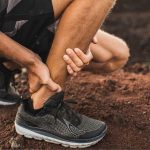What is plantar fasciopathy & why is it more common over summer?
Summer is well and truly here and it is often around this time of year we see an increase in the number of people presenting with heel pain or pain under the arches of their feet. A common cause of pain in this area is a condition called plantar fasciopathy, also known as plantar fasciitis.
The plantar fascia is a strong band of connective tissue that runs along the base of your foot from your heel to your toes. Plantar fasciopathy is an overload injury to the plantar fascia. Plantar Fasciopathy commonly presents as a sharp pain under the heel or arch of your foot. It can be particularly sore on your first few steps in the mornings, upon standing after sitting for a while, with standing for longer periods of time or after periods of intense activity such as running, especially if your running load has changed. It may also occur with footwear changes, especially if your shoes have a thin or flat sole, or if you’ve been going barefoot.
So why is plantar fasciopathy so common in summer? Most people love to get out and about in the warmer weather, and this increase in activity can put repetitive stress on your plantar fascia. This can cause irritation, inflammation and changes to the fibres of the plantar fascia. During the warmer conditions we often put aside our boots and closed in shoes and choose to wear summery shoes instead such as sandals, thongs or even no shoes at all. These shoes (or no shoes) provide much less support for the tissues and structures in the foot. Taking care of your feet during these warmer months, wearing good footwear and not going too hard too fast with your activity can all help to prevent this condition.
Physiotherapy is an effective treatment option in the management of plantar fasciopathy. Your Physiotherapist will discuss with you your training and exercise loads and how you can reduce the overall stress on the plantar fascia, and offer pain management strategies. A combination of soft tissue techniques to the foot and lower limb, taping and in shoe support can be provided by your Physiotherapist to help reduce your pain. Your Physiotherapist will then prescribe exercises and stretches aimed at increasing the strength and mobility around your foot, ankle and lower limb. An appropriate graduated load management program is also important for your successful return to full activity and sport, and for keeping you out and about in the sunshine.
If you have a niggle or are experiencing new pain, don’t hesitate to book in with one of our wonderful Physiotherapists here.






